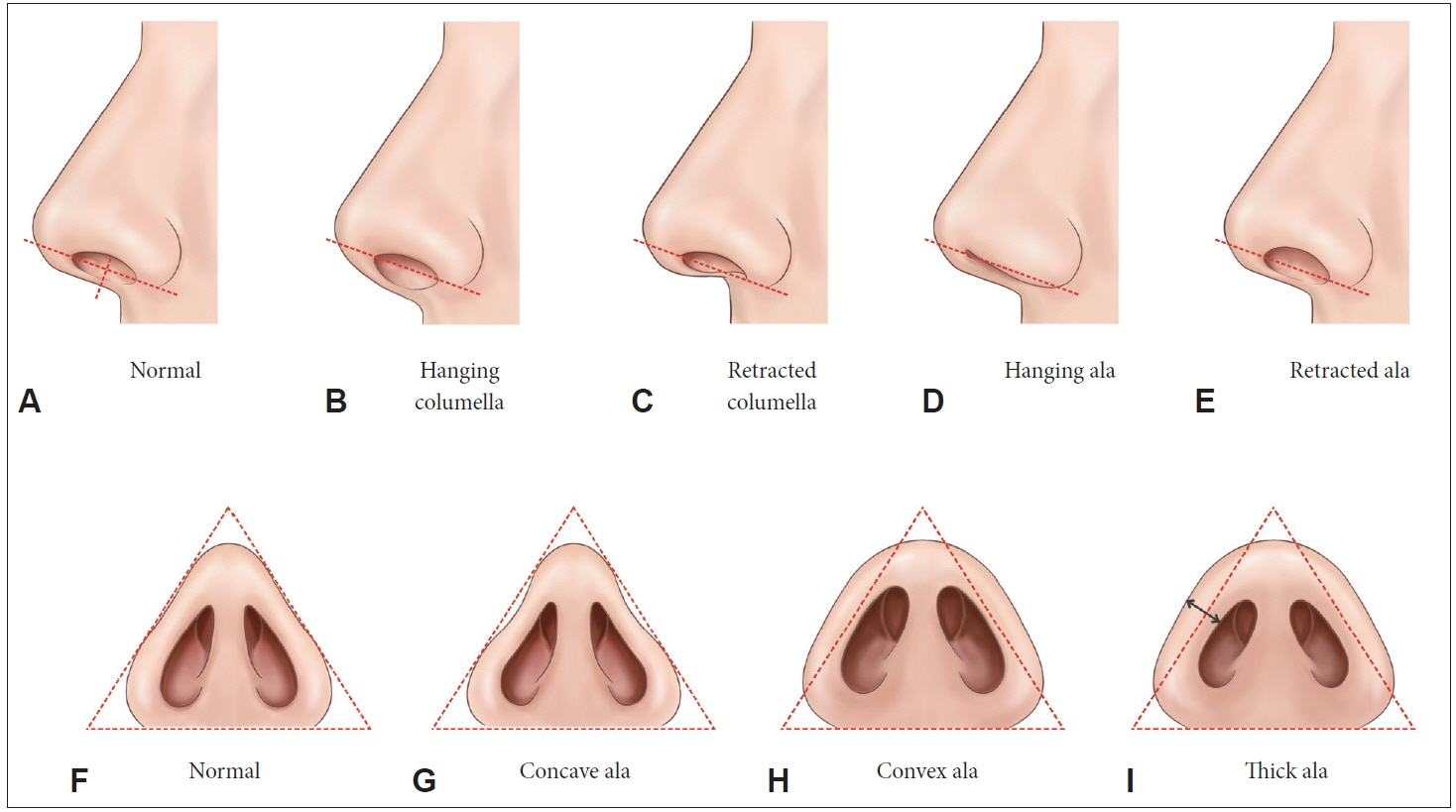J Rhinol.
2021 Nov;28(3):153-157. 10.18787/jr.2021.00365.
Alar Rim Deformities in Korean Primary Rhinoplasty Patients
- Affiliations
-
- 1Department of Otorhinolaryngology-Head and Neck Surgery, National Medical Center, Seoul, Republic of Korea
- 2Department of Otorhinolaryngology-Head and Neck Surgery, Ewha Womans University College of Medicine, Seoul, Republic of Korea
- 3Department of Otorhinolaryngology-Head and Neck Surgery, School of Medicine, Kyung Hee University, Seoul, Republic of Korea
- KMID: 2522784
- DOI: http://doi.org/10.18787/jr.2021.00365
Abstract
- Background and Objectives
The alar-columellar relationship plays an important role in the esthetic balance of the nose. We analyzed alar rim deformities and aesthetic concerns and expectations among patients by deformity type in Korean primary rhinoplasty patients.
Materials and Methods
Retrospective photographic analysis was done on 336 patients planning to undergo primary rhinoplasty at Kyung Hee University Hospital at Gangdong. We categorized their alar rim deformities as normal, hanging columella, retracted columella, hanging ala, retracted ala, convex ala, concave ala, thick ala, and a combination of the above. Patients’ aesthetic concerns and expectations about their nose were analyzed by preoperative questionnaire.
Results
Of the enrolled patients, 38 (11.3%) had no alar rim deformities, and the other 298 patients (88.7%) had one or more deformities. The most prevalent alar rim deformity was hanging ala (59.2%), followed by convex ala (53.3%) and thick ala (32.1%). Male patients were more likely to have convex ala and retracted columella than female patients. More than one-half of the patients (64.1%) had two or more deformities and tended to be young (p=0.028). Patients with thick ala had several reasons for being dissatisfied with their nose and various demands for correction.
Conclusion
Distinctive characteristics of alar rim deformities should be considered in surgical planning in order to obtain satisfactory results in Korean primary rhinoplasty patients.
Keyword
Figure
Reference
-
References
1. Unger JG, Roostaeian J, Small KH, Pezeshk RA, Lee MR, Harris R, et al. Alar contour grafts in rhinoplasty: a safe and reproducible way to refine alar contour aesthetics. Plast Reconstr Surg. 2016; 137(1):52–61.2. Totonchi A, Guyuron B. Alar rim deformities. Clin Plast Surg. 2016; 43(1):127–34.3. Gunter JP, Rohrich RJ, Friedman RM. Classification and correction of alar-columellar discrepancies in rhinoplasty. Plast Reconstr Surg. 1996; 97(3):503–9.4. Choi JY. Alar base reduction and alar-columellar relationship. Facial Plast Surg Clin North Am. 2018; 26(3):367–75.5. Guyuron B. Alar rim deformities. Plast Reconstr Surg. 2001; 107(3):856–63.6. Kim JH, Park SW, Oh WS, Lee JH. New classification for correction of alar retraction using the alar spreader graft. Aesthetic Plast Surg. 2012; 36(4):832–41.7. Herruer JM, Prins JB, van Heerbeek N, Verhage-Damen GWJA, Ingels KJAO. Negative predictors for satisfaction in patients seeking facial cosmetic surgery: a systematic review. Plast Reconstr Surg. 2015; 135(6):1596–605.8. Hah YM, Jung SY, Kang JW, Huh JH, Min JY, Kim SW, et al. Psychological characteristics and aesthetic concerns of male patients seeking primary rhinoplasty. Korean J Otorhinolaryngol-Head Neck Surg. 2018; 61(5):252–7.9. Jung DH, Kwak ES, Kim HS. Correction of severe alar retraction with use of a cutaneous alar rotation flap. Plast Reconstr Surg. 2009; 123(3):1088–95.10. Jin HR, Won TB. Rhinoplasty in the Asian patient. Clin Plast Surg. 2016; 43(1):265–79.11. Farkas LG, Hreczko TA, Deutsch CK. Objective assessment of standard nostril types--a morphometric study. Ann Plast Surg. 1983; 11(5):381–9.12. Hwang TS, Kang HS. Morphometry of nasal bases and nostrils in Koreans. Ann Anat. 2003; 185(2):189–93.13. Tanna N, Nguyen KT, Ghavami A, Calvert JW, Guyuron B, Rohrich RJ, et al. Evidence-based medicine: current practices in rhinoplasty. Plast Reconstr Surg. 2018; 141(1):137e–51e.14. Yu MS, Jang YJ. Preoperative computer simulation for Asian rhinoplasty patients: analysis of accuracy and patient preference. Aesthet Surg J. 2014; 34(8):1162–71.15. Yang F, Liu Y, Xiao H, Li Y, Cun H, Zhao Y. Evaluation of preoperative and postoperative patient satisfaction and quality of life in patients undergoing rhinoplasty: a systematic review and meta-analysis. Plast Reconstr Surg. 2018; 141(3):603–11.16. Wilson JB, Arpey CJ. Body dysmorphic disorder: suggestions for detection and treatment in a surgical dermatology practice. Dermatol Surg. 2004; 30(11):1391–9.
- Full Text Links
- Actions
-
Cited
- CITED
-
- Close
- Share
- Similar articles
-
- Diagnosis and Treatment of Alar Rim Deformities
- Correction of nostril show
- Nasal alar rim redraping method to prevent alar retraction in rhinoplasty for Asian men: A retrospective case series
- A Novel Approach for Full-Thickness Defect of the Nasal Alar Rim: Primary Closure of the Defect and Reduction of the Contralateral Normal Ala for Symmetry
- Frequently Used Grafts in Korean Rhinoplasty: Nomenclature and Definitions


